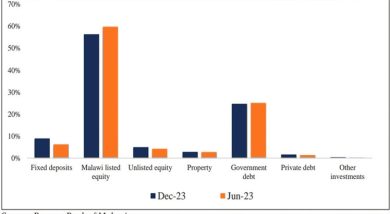Little relief as exports falters
Despite poor performance of the country’s top export earners, legumes would not be able to complement the traditional export crops due to the existing challenges facing the sector, an agricultural commentator has said.
In a written response on Tuesday, Tamani Nkhono-Mvula said while legumes could really be an alternative source of forex, much of the Malawi legumes have been facing a lot of challenges on the international market.

He said: “For instance, our groundnuts face a lot of challenges due to high content of aflatoxins. We literally lost the European market share of groundnuts which we dominated in the 1980s because of this problem.
“Soya beans face a lot of challenges from other large producing countries like Brazil while other varieties like pigeon peas do not have a reliable market as India, which used to the main buyer, usually fluctuates in demand.”
To reverse the situation, Nkhono-Mvula said there is need to strengthen the local demand by ensuring local value-addition, consumption and good treatment for such things as aflatoxins.
Reserve Bank of Malawi (RBM) recent monetary policy report indicates that Malawi’s terms of trade growth is projected to remain neutral over the medium-term, mainly due to the weak performance of the tobacco industry during the year 2019 season compared to the preceding two years.
Besides tobacco, other major exports for Malawi are sugar and tea whose prices remained flat as well, due to among others reduced demand induced by the Covid-19 pandemic.
International Trade Centre (ITC) also observes that over the course of the past 15 years, there has been a marked slowdown in the growth of Malawi’s major traditional exports, such as sugar, tea and groundnuts, which has been accompanied by strong growth in imports, creating an overall trade imbalance.
This year’s tobacco selling season closed last week with the country realising $173.5 million (K130 billion) from the top export earner, which is 27 percent below the $237 million (K175 billion) realised during last year’s growing season.
On the other hand, tea, touted as the second largest export earner with 98 percent of the commodity being exported, is also facing challenges with the Tea Association of Malawi figures indicating that as at July 2020, the country has sold 32 million kilogrammes (kg) of tea at an average price of $1.30.
Last year during the same period, the country sold 36 million kg at an average price of $1.60
Cotton, which has also been among the top export earners for years, has been facing a difficult season with farmers selling the commodity at as low as K150 per kg, despite government setting the minimum price at K389 per kg.
Aicc chief executive officer Felix Lombe said trading cartel of grain and legumes is killing the profitability of the legumes sector on small holder famers.




